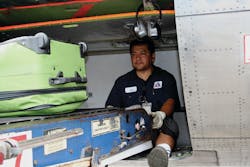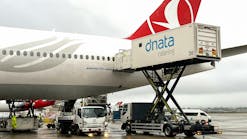Ergonomics: Redesign The Work By Paying Attention To The Worker
Ergonomics is a big word, but the interpretation is simple enough – “take care of your body.”
Ergonomics, synonymous with human engineering and repetitive motion/muscular stress studies, considers the interaction between the human body and physical work. The application to ramp personnel is almost endless in scope. Recent OSHA studies show that nationally there are 50 workers injured every minute of a 40-hour workweek. In 2013, that added up to 5,233 injuries, with average injury costing $20,000 each.
Closer to home, 60 percent of all injuries per month can be attributed to sprains and strains, according to United Airlines.
Work-related musculoskeletal disorders, including those of the neck, upper extremities and low back are one of the leading causes of lost workday injury and illness. These can affect ramp personnel as they complete routine tasks involving movements, such as lifting heavy items, bending, reaching overhead, pushing and pulling heavy loads, working in awkward body postures and performing the same or similar tasks repetitively. Exposure to these known risk factors for musculoskeletal disorders increases a worker's risk of injury.
The good news is it takes time to build up to a soft tissue injury; most are not a one-time event, so being proactive can pay off handsomely.
REDESIGNING THE WORK
Implementing an ergonomic process that redesigns work practices to avoid injury has proven positive in protecting workers against injury. Management would be wise to involve ramp agent in the process by soliciting their input and suggestions on which parts of the body are subject to stress, and how to re-engineer processes, postures, and body movements to avoid injury.
Remember, you can’t redesign the worker, but you can redesign the work practice. Early reporting of muscular stress will provide insight in identifying and evaluating changes that should take place in an ergonomic assessment. Early reporting helps to reduce the progression of the symptoms and arrest the development of serious injuries involving lost time from work and expensive medical claims for treatment.
To gain the most benefit from controlling injury hazards, the ergonomic process should not be just a one-time focused project, but should be woven into the fabric of the station’s culture continuously over time. Of course, training to the process is paramount to success. Employees will need to understand how and why these injuries are likely to occur, as well as how to protect themselves and the changes that are necessary to affect that end.
Identifying the risk factors can be accomplished by asking some pertinent questions about work practices:
- Are a ramp agent’s arms lifted over the head to perform work above the body?
- Are ramp agents in awkward postures, twisting and bending the torso?
- Are ramp agents holding unbalanced or fatiguing postures or simply remaining in a posture for a long time?
- Are ramps agents using smaller muscles to exert force rather than larger muscles?
- Are there sudden exertions like vibrations, jerks, or slams to the ramp agent’s body?
- Are ramp agents using forceful gripping or squeezing?
- Are ramp agents always using the same hand for repetitive tasks?
STRESS-FREE SOLUTIONS
Solutions to avoiding this kind of muscle stress include a combination of changes in the station areas and stretching exercises for personnel to incorporate into their workday.
First and foremost, make sure your crews are paying attention to what their bodies are telling them. Take a good look at how everyone on the ramp is positioned. Are they crouching over your work? Is every muscle in their necks and backs tensed and under strain? Does everyone’s wrists hurt after working their shift? These are clues to improve work practices.
Also, consider varying tasks throughout the day. This may take a little planning, but think about the jobs your ramp agents do. If the first requires them to sit or squat for a long time, have the next job be one where they can stand up, stretch their legs and use different muscles.
Stretches throughout the day relieve stress and fatigue. They should be gentle and comfortable holding for 30 to 60 seconds. Stretching the thighs, the chest, low back calves, hips, and both sides of the torso regularly is taking a pro-active approach to managing potential injury. Developing core strength assists with lifting or moving heavy objects. Aligning your body by bending with your butt out and using both arms to lift protect your spine and discs. It is also helpful to bring objects to be lifted closer to you to gain leverage.
The aim is to find the best fit between the person and job conditions.
Of course this does not just apply to the workplace. Try not to ignore the fact that injuries are just as likely or even more likely to occur outside the workplace, especially at home, simply because we likely do not focus as much on safety at home as we do at work.
Many of us wear our personal protective equipment religiously on the job, but do not even think of putting it on in our own garage even if we are doing similar tasks. When you really think about it, employees who injure themselves at home still have lost time from work and claims for medical costs.
Implementing ergonomic processes and making changes to prevent costly injuries need not be expensive or difficult. There is a plethora of ergonomic strategies available online. With some research you can develop a plan, train to that plan, and implement it. Employees will feel better and likely be more productive, complain less, and miss fewer workdays.
About the Author: DeborahAnn Cavalcante leads Diversified Aviation Consulting (DAC) and along with her associates has firsthand experience in air carrier operations, private charter aircraft, general aviation operations, military/civilian interface, FBO management, maintenance repair station training, safety training, human factors training, and customer service training. For more information on DAC visit http://www.dac.aero.




